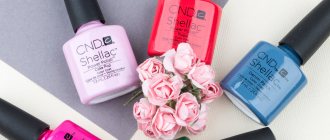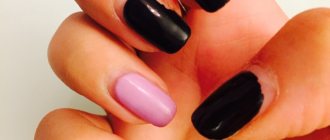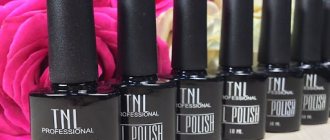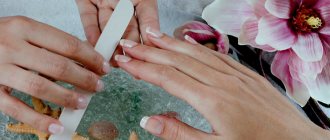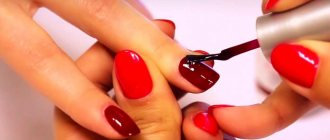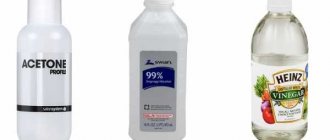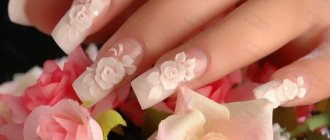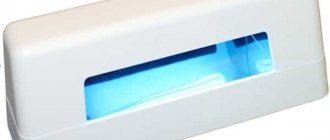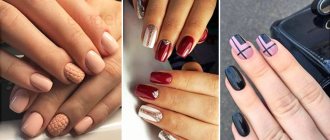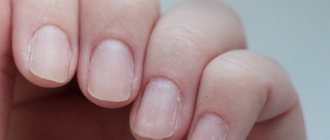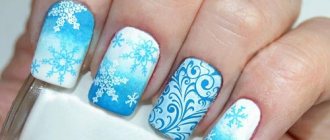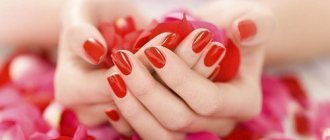Home page » Beauty » Nails
Author of the article
Svetlana Pavlikhina
Reading time: 6 minutes
AA
Gel polish is a durable coating. The procedure for performing such a manicure is quite complicated. You need to know all the intricacies of technology so as not to be disappointed. Degreasing deserves special attention. It’s worth figuring out what you can use to degrease your nails before applying gel polish.
Is it necessary to degrease your nails before applying gel polish?
Many fashionistas wonder whether it is necessary to degrease the surface of the nail before applying gel polish. The answer is clear - yes . Without performing this procedure, the desired result cannot be achieved.
Moisture and residues of any substances on the nail plates prevent uniform baking, which is why the manicure is short-lived. The coating begins to peel off after just a few days.
What mistakes can you make when using degreaser?
Now let's talk about how not to use a degreaser and what mistakes you can make in operation.
- Using regular wipes or cotton pads instead of lint-free ones
- It is necessary to degrease not only the nail plate, but also the area of the proximal folds, lateral ridges, etc.
- You can’t apply a base or primer immediately after degreasing - just wait a couple of minutes for the surface to dry and start degreasing the rest of your nails
Rules for choosing a professional product
When choosing professional products, you need to pay attention to the composition. You should find out in advance what degreasers are available in order to choose the right option.
Compound
The choice of product should be made taking into account its composition.
Conventionally, solutions are divided into the following groups:
- Acidic . A pronounced effect is noted. The nail plate is cleaned of the smallest scales. It is possible to provide reliable grip for a long period.
- Acid-free . A gentle option. There is a gentle cleansing of the nails without damaging their integrity.
When choosing, you should take into account the natural thickness of the nails, their strength, and a possible allergic reaction to the components included in the degreaser. The load that will be placed on the coating is taken into account.
If you frequently perform manicures, it is recommended to give preference to acid-free options. If the environment will aggressively affect your nails, you should use acidic products. Their use is justified before a trip to the sea.
Types of professional products
The products used before applying artificial turf are divided into several types:
- Primer . A universal option. With its help, the nail plates are degreased, their top layer becomes looser, providing reliable adhesion. After applying the primer, you should not touch your nails, otherwise all steps will need to be repeated.
- Dehydrator . Belongs to the group of gentle ones. Designed to get rid of excess moisture. It is not as effective as a primer, but its use does not destroy the nail structure. Gel polish is applied immediately after using the dehydrator. You can’t hesitate, because the water balance is restored quickly.
- Klinser . Designed to remove the sticky layer after manicure. Among these tools there are universal ones, so they can be used at the preparatory stage. The main thing is to study the scope of application.
When choosing, you need to rely on your own preferences. Expert advice is taken into account. It is best to purchase products from well-known brands that have a good reputation.
Types of degreasers
Degreasing the nail is a mandatory ritual before covering a natural nail with any material. This can be done either with a single-phase liquid or with others that have additional properties - removing excess moisture from the nail, removing stickiness after polymerization of the gel, etc.
Professional degreasers come in three types, each of which performs its own functions.
Dehydrator
A multifunctional product that replaces many bottles - a dehydrator. The spectrum of its action is so wide that the need to purchase other products simply disappears. But a “proper manicure” involves using the product as one of the stages of nail treatment before covering it with any artificial material. Liquid is needed for the following purposes:
- remove all contaminants from the nail, including sweat and fat deposits (but except for decorative coatings);
- disinfect the surface of the nail;
- dry (that is, dehydrate - deprive the upper layers of the nail of moisture).
Such a product does not violate the pH of the nail plate, and, if necessary, can restore it. In addition to all the above abilities, the dehydrator can be used to remove stickiness after gel coating.
It is recommended to apply the product with a brush, and distribute it evenly over the nail with a special napkin that does not leave any traces (lint, fibers, or other particles). Don’t rush and treat all your nails with a dehydrator at once. By the time the second hand gets to apply the gel (shellac, gel polish), the nails will have time to become dirty more than once. This will not only double the cost of the product, but will also result in wasted time.
Klinser
A beautiful manicure is incomplete without the use of a clinser. It is simply necessary if such compositions are used that, after polymerization, leave stickiness on top of the coating. But this product is not only characterized by the function of removing the sticky layer. It is used as a base for subsequent coating with artificial materials, which results in:
- degreasing marigold;
- elimination of other contaminants;
- antiseptic effect.
Due to the alcohol content, the cleaner can easily be used to treat not only nail plates before coating, but also manicure accessories and a drying lamp.
Essentially, this is a universal liquid that can perform all the necessary functions to create the perfect manicure. But you still shouldn’t give up the dehydrator. It is one of the mandatory stages of nail treatment before coating and nail design.
Primer
A primer is applied for a good connection (grip, adhesion) of the natural nail with almost any artificial coating. It is a “ground base” in the form of a gel-like liquid. Features of the product are:
- preventing the harmful effects of applied materials on the nail;
- removal of any “dirty” deposits;
- dry the nail plate.
Without this product it will be difficult to get a manicure for a long time. The primer opens the scales of the nail plate and settles there tightly.
Subsequent coatings no longer deal with the nail itself, but with a layer of primer; it acts as an “intermediary” between the surfaces. High-quality adhesion when coating gel polish and other materials is ensured not only by using a primer, but also by following all stages of the degreasing and nail preparation procedure.
Professional hairdressers, for example, before the extension procedure, choose a suitable primer for their client. They focus on the expected result and the condition of the nail plate. You can choose an acid-free or acidic primer. They differ from each other precisely by the presence of acid in the composition.
An acid primer-degreaser is more aggressive to both the nail and the skin surrounding it. It can cause damage to your nails if you use the product frequently. Contains methacrylic acid, so apply the primer very carefully to avoid burns.
The product thoroughly dries out all layers of the nail, which has a negative effect on it. Using an acidic agent, you can ensure more reliable adhesion of subsequent layers of coating to the natural nail. Excellent as a base before acrylic extensions.
An acid-free degreaser carefully removes excess fat and other dirt without harming the structure of the nail. After systematic use of this product, your nails will not peel or crumble. It also does not cause irritation, burning, itching, redness of the skin around the nail and other unpleasant sensations. Suitable for use before applying shellac or any gel polish.
Home Remedies Review
You can replace nail degreaser with various improvised means. It is worth considering which of them can be used at home.
Alcohol
You can degrease your nails with alcohol. This is an affordable, effective remedy.
Among its advantages is its disinfecting effect.
When applied, the damage caused by polishing is disinfected while the cuticle is removed. But alcohol has one drawback: it dries out the surface greatly, so it should be used rarely.
Boric acid
Boric acid will help carry out the preparatory procedures. It is based on alcohol, but does not act so aggressively on the nail plates. Its frequent use is also not recommended due to its negative effects on the skin and nail plate.
Lemon acid
Citric acid or lemon juice is often used for degreasing purposes. The results of such actions vary. A solution based on citric acid is not able to remove excess moisture, so thorough drying is necessary before performing a manicure.
The lemon itself often leaves microparticles on the surface, leading to peeling of the coating, and the acid it contains corrodes the nails.
Soap and water
Regular soap can be used. The main thing is that it does not contain moisturizing components. It is enough to briefly immerse your hands in soapy water and then dry your nails.
Instead of soap, a degreasing dishwashing detergent is often used. When using it, special attention is paid to the side ridges and cuticle.
Formic alcohol
The product can be used for degreasing. You should remember safety precautions. All actions must be performed with gloves.
Formic alcohol is an aggressive option; it dries out the skin and all layers of the nail plate. It is used in exceptional cases.
Vinegar
Ordinary table vinegar can remove oily shine and dirt from the nail, and dries out the surface. But its effect is quite aggressive, so the product is rarely used.
Nail polish remover
It is necessary to take into account the composition of the liquid: if it contains acetone, then it can be used for degreasing. In the presence of oils and glycerin, the desired result cannot be achieved: an oil film forms on the surface, preventing strong adhesion.
Cologne
The most ordinary triple cologne will cope with the task.
You should not clean your nails with eau de toilette, because it contains many perfume additives that prevent the artificial material from reliably fixing.
How to replace degreaser at home
If you don’t have a special composition at hand, you can resort to other means that have a similar effect. We suggest you familiarize yourself with the two most common non-professional degreasers.
Boric acid instead of a degreaser before extensions
Boric acid is the simplest and most affordable product that can be used to degrease nails before the extension procedure. An alcohol solution can be purchased at any pharmacy, and it will perfectly remove all remaining oil from the nail.
Alcohol
Alcohol is most often used for this purpose, as it both removes fat and helps remove various oil-based cosmetics. Also has a disinfecting effect. But this liquid dries out the skin and the plate itself too much, and it is not recommended to use it constantly.
Rules for degreasing nails
To properly degrease your nails, you need:
- Wash your hands thoroughly and dry them with a towel. It is recommended not just to rinse your brushes, but to keep them in warm water for about five minutes. During this time, the cuticles soften.
- Using a pusher spatula, push the cuticle to the base of the nail.
- Remove dead tissue with scissors or a trimmer.
- Using a ceramic or glass file, sand the surface and remove shine.
- Remove dust with a brush.
- Dip the brush into degreaser.
- Squeeze excess onto the edge of the bottle.
- Apply the product to each plate, moving from the cuticle to the edges.
- Wait time for the solution to dry.
- Apply base protective coating and gel polish.
When performing these manipulations, you must adhere to the following recommendations:
- To apply liquid in the absence of a brush, use lint-free wipes. Cotton pads cannot be used for this purpose, because small fibers remain on the surface, which will cause the coating to lie unevenly and the manicure will look untidy.
- Each nail should be wiped as thoroughly as possible, paying attention to the hole.
- After removing the fat, you should not touch any objects. Also, do not touch the nail plates with your fingers.
Reviews of nail degreaser
When studying the opinions of manicurists about various products, you need to take into account that there is a moment of individual intolerance to the components, bias. The best way to form your own opinion is to test the product yourself.
Reviews of degreasing compounds from different companies are given below.
Lena, 28 years old, Penza
I use the proven Kodi Nail Fresher. The liquid has never let me down. The quality corresponds to the cost, result, and volume of the tube. Among the shortcomings, I would like to note the brush – too small, dense (but I’ve already gotten used to it); unpleasant smell. There were no detachments or problems with nails when using the degreasing composition of this company. The brand really cares about the quality of its products, this is evident from the result of the work; there was no desire to replace it with another. I recommend.
Valentina, 41 years old, Krasnodar
I do nail strengthening at home. This is my extra income. I do marigolds for myself and my girlfriends. Regarding the degreasing liquid, I admit, I had to replace it several times with regular pharmaceutical alcohol. The result was almost the same, the coating stayed on normally. Later I bought a primer in the store because I read that regular use of alcohol on nails harms the plate. But for a couple of times it turned out to be an excellent substitute, the girls are happy.
Oksana, 25 years old, Donetsk
My review of Severina degreaser. The PNB product I tried ran out, so I decided to experiment and replace it with a new one. Before buying Severina, I looked at the reviews, saw positive ones, calmed down, and bought it. Having problems with my nails and skin, I went online again and found a lot of negative feedback! The first thing I encountered was the smell. Harsh, unpleasant, corrosive to the eyes! I endured the inconvenience and covered my nails with gel polish. An hour later they started to hurt! I tried not to pay attention, and in the evening I looked at my fingers that were in contact with the degreaser and was horrified - my skin was corroded! She began to peel off. Frightened, she took off the covering. Everything is fine with the nails, but who knows what would have happened to them if it had been on longer... Than such a product, it is really better to replace it with homemade preparations, for example, boric acid. My advice – don’t be flattered by the low price and take care of your health!
What happens if you don't apply a degreaser?
Many girls underestimate the importance of the degreasing procedure. If these steps are neglected, getting a neat, long-lasting manicure is very problematic: the coating soon begins to peel off, and you have to resort to re-applying gel polish.
True, there are experienced masters who manage to achieve an ideal result without first degreasing the nails. But this is only an exception to the rule.
Comparison of professional and home remedies
All alternative options pose a potential threat to nails.
The harm from using professional products is reduced to zero. They also have an aggressive effect, but do not lead to disruption of the water balance or thinning of the nails. After their use, the plates do not delaminate.
There is no guarantee that home remedies will be absolutely safe. Therefore, when choosing between professional and alternative options, you need to understand all the risks. Trying to save money can ruin your nails.
